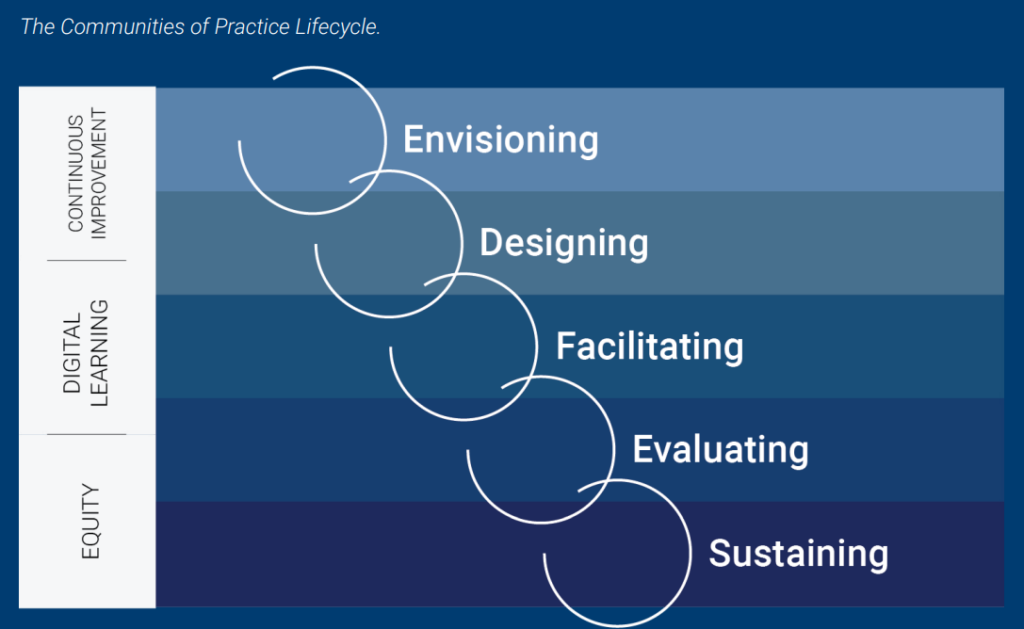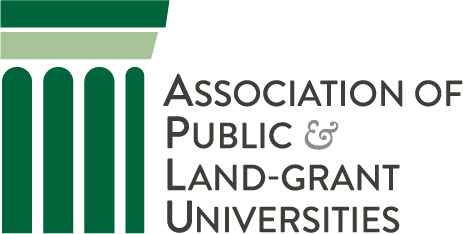In partnership with Achieving the Dream, the Association of Public and Land-grant Universities, and the Online Learning Consortium, Every Learner Everywhere recently published Communities of Practice in Higher Education: A Playbook for Centering Equity, Digital Learning, and Continuous Improvement.
The playbook defines a community of practice as a group of people who share information, experiences, and practices through collaboration and dialogue in a common area of interest. A community of practice helps practitioners — in healthcare or education, for example — share information and experiences, explore similar problems and opportunities, and develop new knowledge. Being member driven, communities of practice can vary widely in the form they take and in the way they operate.
The authors of the playbook analyzed examples of communities of practice in higher education and identified common elements and processes. They identify five stages of communities of practice work — Envisioning, Designing, Facilitating, Evaluating, and Sustaining — and devote sections of the playbook to each stage. The playbook highlights strategies for managing the process and embeds considerations related to equity, digital learning, and continuous improvement. The playbook is accompanied by a literature review on communities of practice.

From Communities of Practice in Higher Education: A Playbook for Centering Equity, Digital Learning, and Continuous Improvement
The appendix to the playbook, which is excerpted and adapted below, profiles 11 examples of communities of practice in higher education that vary in their models, formal structure, and subject matter. The examples include faculty, librarians, academic support, and student affairs professionals, and they include modalities ranging from in-person meetings to asynchronous online sharing.
Examples of communities of practice
1. University of Colorado Boulder hosts an Online Pedagogy Community of Practice to amplify existing exemplary work, but more importantly the mission of the community is to “create a space for dialogue that builds trusted relationships among collaborators by sharing effective strategies and practices, encountering challenges with empathy, and facing change with community. This is not ‘just another meeting’ — this is a network of trusted collaborators invested in doing what we do, better.”
2. Librarians at the University of Nevada, Las Vegas developed and implemented an inclusive teaching community of practice with members of their instruction department to foster a culture of discussing equity in higher education, to develop and implement inclusive teaching practices, and to cultivate a shared responsibility to be equitable instructors and colleagues. The article highlights the importance of library workers from majority groups, especially white library workers, engaging in meaningfully in educational equity work to lessen the burdens faced by those with marginalized identities, particularly minoritized library workers, and to ultimately foster educational equity for all by creating inclusive workspaces, libraries, and learning experiences.
3. Oregon State University faculty are invited to organize communities of practice through a proposal process through the Office of Faculty Affairs. Approved communities are required to submit a summary report. Current and past communities of practice include Inclusive Excellence in Marine Programs, Research for Undergraduates Network, and the Community for the Advancement of Antiracist Instruction.
4. The University of Washington invites colleagues with similar information technology interests to join communities to “share common skills, technologies, or methodologies” to identify practices that promote the participation and success of people with disabilities in education and careers. The communities do not meet but instead communicate via email. Some communities include AccessCyberLearning, Accessible Distance Learning, Broadening Participation, Universal Design in Higher Education, and Veterans.
5. The University of California, Santa Barbara has a Student Affairs Assessment Initiative community of practice to support the professional development of student affairs staff. The topics are centered around student services and student affairs activities, such as “Transfer Students’ Experiences Navigating Financial Aid.”
6. As a response to mitigating COVID-19 effects and in the spirit of “leading with racial equity,” The Washington State Board for Community and Technical Colleges offered technology-mediated communities of practice that encouraged social connection, skill building, information aggregation, problem solving, and the sharing of resources. They currently have STEM faculty communities of practice and workforce communities of practice.
7. College of DuPage uses inquiry groups and affinity spaces within the communities of practice umbrella. College of DuPage defines inquiry groups as communities of practice centered on and built around examining topics of special interest. Affinity spaces provide participants with common interests a collective voice, a sense of community, and professional and personal support.
8. Orange Coast College has communities of practice specifically targeted to and hosted for part-time faculty. The experiences include celebratory experiences and teaching- and learning-centered experiences, such as outcome-centered teaching, enhancing the lecture experience, and engaging with instructional resources.
9. The California State University San Marcos Office of Success Coaching offers “Wisdom Exchange” opportunities, which are meant to serve as communities of practice to support shared participation for all.
10. The Association of Public and Land-grant Universities in partnership with Every Learner Everywhere created a Guide to Building a Faculty Learning Community. The resource describes how to build and maintain a faculty learning community, details logistics, and provides a case study from Colorado State University along with testimonials from instructors.
11. Through their ShapingEDU initiative, Arizona State University hosts several communities of practice that expand the boundaries of their institution and invite practitioners from around the globe. Some examples/case studies of communities include Community of Practice in Open Education Resources and Pedagogy, Educational Technology and Media MOOC, Faculty Engagement Academies, and FLEXspace — the Flexible Learning Environments Exchange.
Download Communities of Practice in Higher Education: A Playbook for Centering Equity, Digital Learning, and Continuous ImprovementThis article is excerpted and adapted from Adams, S., Tesene, M., Gay, K., Brokos, M., Swindell, A., McGuire, A., & Rettler-Pagel, T. (2023, Mar 7). Communities of Practice in Higher Education: A Playbook for Centering Equity, Digital Learning, and Continuous Improvement. Every Learner Everywhere. https://www.everylearnereverywhere.org/resources/ communities-of-practice-in-higher-education/
The playbook is a collaboration of Achieving the Dream (ATD), the Association of Public and Land-grant Universities (APLU), and the Online Learning Consortium (OLC) in partnership with Every Learner Everywhere.





